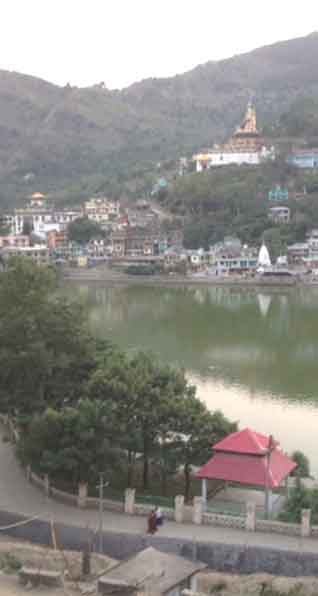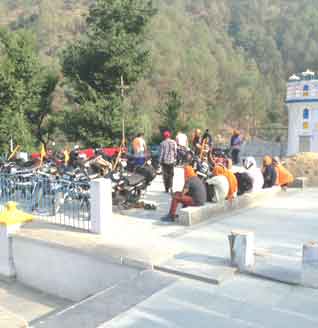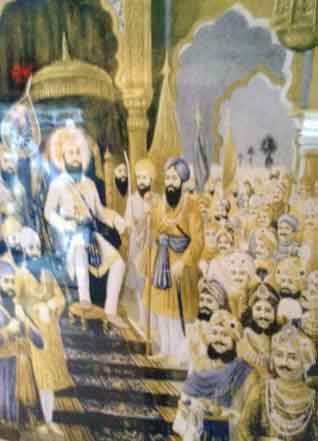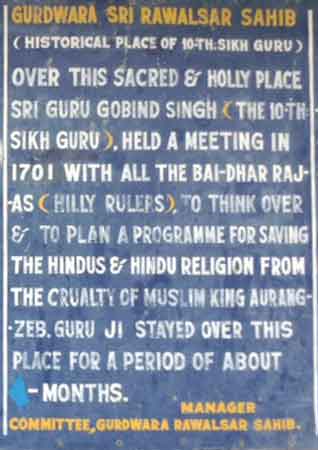Travel
Ever Heard of Rawalsar?
DYA SINGH
We are in Rawalsar in the lower Himalayas.
“So, this is your 'bhujangi'?” a Nihang asks me, pointing to my ten-year-old grandson.
I had heard the term before as a young man amongst the 'granthi fraternity' in Malaysia, but never knew its true import till I visited Rawalsar.
'Bhujangi' to me just meant 'youngster' or perhaps 'son'. I used to be referred to as my venerable father's 'bhujangi'.
The old Nihang tells me of the legend of the mythical king of snakes of Rawal who, having taken on the human form, visited and paid obeisance to Guru Gobind Singh. The Snake King, goes the story, foretold of a new breed of warriors who would free the land of tyranny: he said they would rise like the ’sons of venomous wipers’ -- bhujangies! -- and haunt the oppressors.
It is therefore this term that Guru Sahib uses in his Dasam Granth bani when referring to young Khalsa. And it has therefore remained since in Nihang parlance as a colloquial term for their progeny.
On Vaisakhi Day in 1701 in these very hills -- a mere two years after the birth of the Khalsa -- Guru Gobind Singh issued his declaration of independence against the terror and tyranny of Aurangzeb, the Mughal Emperor who held sway over much of the subcontinent.
A gurdwara at Rawalsar (in present day Himachal Pradesh), which is about 25 km from the township of Mandi, commemorates the place where the proclamation was made.
We’ve already spent a week in 45C degree-heat -- down to 31 at night! -- in Ludhiana. I was ready to crawl into a fridge. My brother, Gurmukh Singh -- always the wise one amongst us -- decides we should head for Himachal’s cooler climes.
We spend a few days in the vicinity of Dalhousie at a scenic spot called Khajjiar, and then move on to Palampur where some friends have their summer residences. Bhai Sahib suggests a visit to nearby Rawalsar.
“What’s Rawalsar?” everyone asks.
He’s horrified that we haven’t even heard of Rawalsar.
I said I know of Anandpur Sahib, Guru ka Lahore, the Sirsa, Kiratpur, Parvaar Vicchorra Sahib, even Manikaran … all in this region, but Rawalsar? Not a clue!
He tells us of its history. Now, I want to visit it.
I am not the 'mathaa-tek-at-every-gurdwara’ type, but the history of Rawalsar intrigues me.
So, after a one-day dash from Khajjiar to Mandi (about 200 km) over some very high passes and through hot and humid valleys -- and some stunning scenery en route -- we reach Rawalsar one late afternoon.
We round a bend on a 4000 ft high mountain-side and we find ourselves in a Tibetan village. A Buddha statue three storeys high sits cross-legged, surrounded by stupas and pagodas, structures of blazing red, maroon and bright yellow - Buddhist colours, all. Are we still in Himachal or in Shangri-la?
Tibetan and Buddhist influences are everywhere. Understandably -- because the Dalai Lama‘s capital in exile is in nearby Dharamsala. And other communities peopled by his followers, such as McLeodgunj, for example. [This was all still Punjab when the 24-year-old Dalai Lama had to flee Tibet in 1959, and while the world twiddled its thumbs, it was in Punjab that he received a warm welcome, with no strings attached. And made it his permanent home!]
Amidst this calming and peaceful atmosphere, surrounded by majestic mountains, is the beautiful lake called Rawalsar.
We check into the Country Inn for the night (very reasonable rates, I might add). I took a quick bath and while the light was good walked over to the gurdwara. Around the lake, which has now been virtually taken over by the Buddhists, there is a beautiful walkway. The water is teeming with fish, eager to be fed. We’ve been warned to look out for snakes though, but haven’t seen any - if you don‘t count our bhujangis.
The historical gurdwara holds a prominent spot atop a hillock but is very small and unspectacular. This needs to change, given the enormity of its significance.
A plaque gives a brief outline of Guru Sahib's visit -- not bad in Gurmukhi, but pretty lame in English. If the intention is to discourage the non-Sikh visitor here, the poor translation should do the trick.
On a stray note - I have come across some rather ridiculous translations and hilarious English usage in general, all over India. The level of English is certainly taking a beating. For example, in a road-side dhaba, a statue was captioned a 'stachu.' A toilet is variously identified as a 'toolet', 'tolet', ’to let’. 'tolate' and, I suppose in honour of the affliction known as “Delhi belly”, 'toolate'!
At a secondary school, a sign advises you of an 'English class in backside'.
Sorry, I digress. Back to the narrative ...
The Gurmukhi part of the inscription at the gurdwara clearly talks of discussing strategies to rid the land of the tyrannous yoke of Aurangzeb, whereas the English version talks of 'plans to save Hinduism ...', etc.
Nevertheless, what I heard from the granthis and sevadars is as follows, in summary: the local Hindu rajas had proved to be too cowardly to resist Aurangzeb’s tyranny, and had turned subservient. That is when Guru Gobind Singh stood up and took on the evil empire.
It is incumbent on us to promote gurdwaras like Rawalsar which have a strong historical significance, instead of building gurdwaras and shrines which are associated with ‘miracles’ and ‘magic‘. I do accept that stories of miracles do lend to 'shardha' (faith) but I think that for the future of Sikhi, we need to keep our history, our 'Gur-itihaas' alive and make our younger generations aware of it.
In that, surely Rawalsar should play an important role in this region, alongside Anandpur Sahib.
The next morning, before heading back to hot and steamy Ludhiana via Kiratpur, we went out for an early morning walk. It was a joy to see the townsfolk, especially Buddhist monks and women, sweeping the streets while twirling their worry beads.
It was also a joy to meet a group of about 40 Sikh youngsters who had travelled on their motor bikes from Fatehgarh Sahib. We talked to them and were pleased to hear that they all knew the significance of Rawalsar. The number of visitors is indeed growing yearly.
Even as we head back, we see more groups of Sikh youths on motor bikes. wearing saffron or black, on similar 'yatras'. And why not? Langar and lodgings are available at most gurdwaras and this is an affordable way to travel, see the country and keep in close touch with our history and heritage.
May Waheguru bless the 'bhujangis' of our future.
Next week … on to Hemkunt.
June 10, 2013
Conversation about this article
1: Harmeet Singh (USA), June 10, 2013, 11:25 AM.
Saving Hindu religion and saving people from the Hindu religion at the same time? Sikhism protects human rights and defends freedoms, but has never had the degrading mission to save Hinduism or any of its practices! In India, Sikhism being morphed and warped to politically support Hinduism, and thus to assist in the subjugation of Sikhs themselves.
2: R Singh (Canada), June 10, 2013, 3:57 PM.
So true, Harmeet Singh ji. Spurious writings increasingly attributed to our Guru Sahib are cropping up and being propagated by katha-vachaks, and we keep retreating under the onslaught. The awakened and learned entities are now to be made out to be venomous snakes, who defend selectively. We had better wake up before it is too late.
3: Mohan Singh (Toronto, Ontario, Canada), June 10, 2013, 8:44 PM.
The Nihang's version is not correct. Bhujangi (Bhuyung) is the Sanskrit word for snake. During the time of Guru Gobind Singh, the Mughals used to identify Sikhs as 'Maar' ('Snake' in Persian). Two young sons of Guru Gobind Singh were also referred to as Maar in the court of the Nawab of Sirhind, who then murdered them. The word 'bhuyung' appears in gurbani over 50 times. Giani Maskeen ji has explained this well in one of his lectures.
4: Gurinder Singh (Stockton, California, U.S.A.), June 10, 2013, 10:36 PM.
Bhujangi means 'son of a snake' or sapolia. There are many chhands in the Dasam Granth titled as "Bhujang Parayat chhand."
5: Gurinder Singh (Stockton, California, U.S.A.), June 10, 2013, 10:42 PM.
Bhujang refers to the smooth and "back and forth" pattern of the snake, which is imitated in the art of gatka. Puraatan Sikhs in battle recited Jaap Sahib while engaged in battle. 'Bhujang' appears 62 times in Jaap Sahib alone.
6: Sangat Singh (Kuala Lumpur, Malaysia), June 16, 2013, 4:56 PM.
What a beautiful piece. Rawalsar was just a vague memory of the hallowed ground where Guru Sahib had walked. Your piece has repaired the hilarious faults in bad English to attract or distract visitors. We are now looking forward to your piece on Hemkunt.






